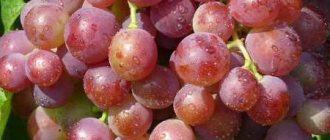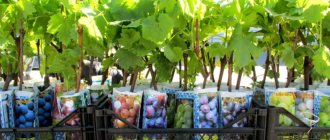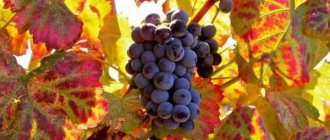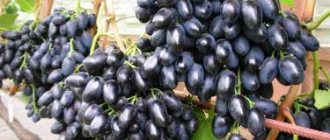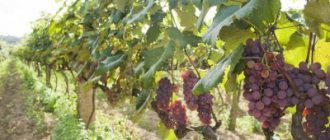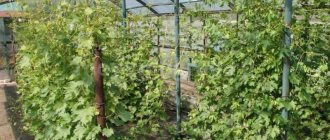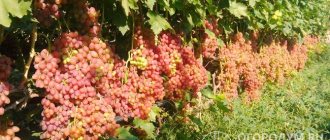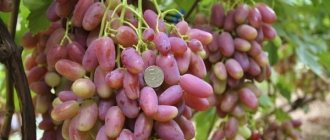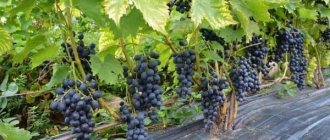Advantages and disadvantages
The “Dubovsky pink” grape has a number of positive characteristics that distinguish it as favorably as possible from other varieties.
The main advantages of the variety:
- Harmonious ripening of berries.
- Early ripeness.
- High yield.
- Pleasant taste and versatility of berries.
- Frost resistance.
- Immunity to a number of diseases.
- Good transportability and keeping quality.
Also, “Dubovsky rose” bushes are decorative and can be used to decorate a site.
There are practically no negative reviews about this variety. Among the disadvantages, gardeners note only the need to normalize the load on the vine , because otherwise the crop takes longer to ripen, and ripe berries rot due to insufficient ventilation.
Diseases and pests, methods of control and prevention
The form of the Dubovsky pink grape is young, so there is little information about susceptibility to diseases. The variety's weak resistance to the oidium pathogen has been revealed, so the bushes are treated with preparations containing sulfur for medicinal and preventive purposes.
Important! The drug “Cumulus” gives good results in preventing outbreaks of oidium. The vines of the Dubovsky pink variety are treated with it in August.
The scheme for treating Dubovsky pink grapes with the fungicide “Cumulus” is shown in the table.
| Parameter | Description |
| Product consumption per 10 liters of water | From 30 to 50 g |
| Processing method | Spraying |
| Number of treatments | From 4 to 6 |
| Waiting period | 1 day |
Origin
The variety is named after the village of Dubovka, Volgograd region, where it was bred in 2009 by breeder S.E. Gusev. The parent plants were the varieties “Yubilei Novocherkassk” and “Red Delight”.
Parents of “Dubovsky pink” - “Anniversary of Novocherkassk” and “red delight”
Reference! The variety is not included in the State Register of Breeding Achievements.
Main characteristics
“Dubovsky pink” is a table grape variety, the bushes of which have a decorative appearance, and the berries are distinguished by the possibility of universal use.
Maturation period and class
“Dubovsky pink” refers to early ripening varieties - the harvest can be harvested within 105-110 days after flowering. On average, the first ripe berries can be picked from the bushes in the second half of August, but this depends on the climatic conditions of the region.
Bush
The grapes are powerful, vigorous, spreading bushes. The leaf blades are large, round in shape, openwork, deeply dissected into 5 lobes, with a smooth surface and without pubescence on the underside. The edges are jagged, the teeth are large, saw-tooth-shaped, have smooth edges and sharp tops.
The flowers on the bushes are both male and female, so there is no need to plant additional pollinating varieties.
Bunches and berries
The clusters are medium-dense or loose, conical in shape, have so-called “wings” or side shoots, large - on average, the weight of the brush is 1.2-1.5 kg, and the length reaches 30-40 cm.
The berries are conical in shape with slightly pointed and curved tips, large, grow up to 3.5-6 cm in length and 3 cm in diameter, weigh on average 14-15 g, but there are specimens weighing 20 g.
The fruits are covered with a moderately strong but thin skin, the color of which, depending on climatic conditions, varies from light pinkish-golden to deep pink. There is a not very thick layer of light waxy coating on the skin.
The flesh is pink, tender, crispy and juicy, containing 1-2 small seeds inside.
The sugar content of the grapes is approximately 21%, there is no data on acidity.
Taste and yield
The taste is pleasant and harmonious. Sweet with a slight nutmeg aroma.
The yield from 1 bush of “Dubovsky rose” is up to 50 kg; you can increase the number of berries by additionally feeding the grapes in the spring.
Reference! A distinctive feature of the variety is the ability to bloom on stepsons and bear fruit repeatedly.
Care
Dubov grapes do not require careful care. The most important procedures are watering and fertilizing. Milking large clusters requires a lot of water; the watering regime is simple: twice a week you need to pour 1.5-2.5 buckets of water to the base of the bush. Organic fertilizing is required, which contains potassium supplements. It is also recommended to periodically loosen the soil and regulate its density; grapes wither on loamy soils. At the beginning of the season, gartering is important in order to give the rows direction, and later attempts are made directly under the bunches. This material will tell you about planting grapes in open ground.
Due to their excessive sweetness, pink Dubovsky berries are very popular with wasps. To protect fruits from insects, protection in the form of bags is necessary.
Disease Prevention
The immunity of Dubovsky pink grapes makes it invulnerable to typical diseases of this crop, such as gray rot, anthracnose and chlorosis. However, if overwatered or overgrown with excess greenery, the bushes can rot and become susceptible to fungal infections. To avoid such situations, you need to follow the water supply regime, as well as carry out spring pruning of non-fruiting shoots. After harvesting, it is important to completely remove all organic waste and burn it. Disease control agents are sprayed no later than the end of April to ensure that the fruit does not contain chemicals harmful to humans. Read about gray rot on grapes here.
Grape leaves affected by mildew.
Trimming
Pruning of Dubovsky pink is carried out in the spring. It is aimed at increasing the yield of the bush; for this purpose, a long type of pruning is used. The bushes are rejuvenated by pruning “at the knot”, carried out before covering the bush for the winter. During the season, unfruitful shoots and unnecessary leaves are removed. But all the whiskers are left, they are necessary for the plant. When pruning, it is important to remember the quality of the tools; the cutter must be well sharpened, and the cut must be made at a minimum angle to the growth line. With each pruning, no more than 15 eyes are left on the plant.
Comparison with analogues
Let's consider “Dubovsky pink” with the table varieties most similar to it. Perhaps this comparison will help you decide on the right grape for you.
| Sign | Variety | ||||
| Dubovsky pink | Rumba | Sensation | Julian | Sofia | |
| Ripening period | 105-110 days | 110-115 days | 100-110 days | 95-105 days | 100-115 days |
| Frost resistance | Up to -24 °C | Up to -24 °C | Up to -25 °C | Up to -23 °C | Up to -21 °C |
| Yield per bush | up to 50 kg | 50-60 kg | 60-80 kg | 50-60 kg | 50-70 kg |
| Bunches | 1.2-1.5 kg | From 800 g to 1.2 kg | From 700 g to 1.5 kg | From 700 g to 1 kg | 800-1200 g |
| Taste | Light aroma of nutmeg | With notes of cherry | Taste of nutmeg | Strawberry flavor and nutmeg aroma | With a nutmeg aftertaste |
| Color | Pink | Amber pink | Yellow-pink with crimson | Pink with lilac tint | Light pink |
| Disease resistance | Average | High | High | High | Average |
| Shelf life | A few months | Up to 6 months | 4-6 months | Up to 20 days | 3-5 weeks |
| Sugar content | 21% | 18-20% | 18% | 28% | 20% |
| Acidity | Not installed | 5-7 g/l | 4-5 g/l | Not installed | Not installed |
Productivity and ripening time
The first signal fruiting occurs in the 2-3rd year after planting, commercial fruiting begins in the 4th - on average, gardeners receive about 15-16 kg from one bush.
The opinion of an experienced Ukrainian winegrower about the yield potential of “Dubovsky Rose” can be found in the following video:
Removable maturity occurs 110-115 days after bud break . If the vine is overloaded, the ripening period increases by 10-20 days.
In the south, the main harvest is harvested in early August, in the northern regions the harvest occurs at the end of August - beginning of September. When the clusters remain on the bushes for a long time, the fruits do not lose their quality. Strong attachment of the berry to the stalk has a positive effect on the keeping quality of the harvested crop. The density of the fruit allows the harvested crop to be transported and stored (in the refrigerator for more than 2 months), and also facilitates the harvesting itself, which guarantees excellent prospects for growing on an industrial scale.
Beneficial features
Per 100 g of Dubovsky pink grapes there are 0.3 g of fats and vegetable proteins, 14 g of carbohydrates (glucose and fructose) and 75 kcal, however, the nutritional value of the berries is increased due to the fairly high content of fiber and tannins.
Also, “Dubovsky pink” contains:
- Vitamin C, which has a beneficial effect on the body's protective functions.
- B vitamins, essential for the nervous system and enhancing cognitive abilities.
- Magnesium, iron and potassium, beneficial for the cardiovascular system.
- Carbohydrates and dietary plant fibers that regulate the functioning of the digestive system.
Consumption of grapes is contraindicated in diabetes mellitus, pregnancy, lactation, gastrointestinal disorders, hypertension and allergies to grapes.
Features of cultivation
No matter how unpretentious this grape variety may be, it still has characteristics and some nuances, so it is impossible to obtain a high-quality and abundant harvest without observing agrotechnical requirements.
Boarding time
The timing of planting seedlings in the ground depends on the climatic conditions of the region. Thus, in areas with harsh and frosty winters, it is better to plant in the spring (end of March), so that the root system has time to adapt and strengthen; in the southern regions, autumn (end of September) planting is practiced, during which the seedlings take root better.
The place for planting grapes should be located on a hill, well lit and protected from drafts. The variety prefers fertile, light soil with good aeration, moisture permeability and neutral acidity.
Watering and fertilizing
You need to water the Dubovsky pink grapes 1-2 times a week, pouring 50-70 liters of water to the base of each adult bush. In this case, you should refrain from watering during flowering and stop it completely 2 weeks before harvest.
In order for the bushes to be healthy and grow and develop well, it is necessary to feed them with fertilizers containing nitrogen, potassium, phosphorus, magnesium, boron and zinc three times a season:
- In spring, before the buds open.
- 7-10 days before flowering.
- In autumn.
Complex mineral fertilizers include Kemira, Novofert, and Aquarin; organic fertilizers include mullein, bird droppings, and compost.
Important! Watering and fertilizing is carried out in special grooves near the base of the bush or through drainage tubes placed during planting.
Trimming
You should trim the shoots into 6-8 buds, shorten the flower clusters, leaving 1-2 pieces on the fruiting shoots. Sanitary pruning is carried out as necessary and involves the removal of diseased and damaged branches or leaves.
Formation should be carried out in accordance with the covering scheme - a multi-armed fan or an inclined cordon.
Diseases and pests
The variety has a fairly high resistance to gray rot, anthracnose and chlorosis, however, if watering rules are violated or there is insufficient ventilation, fungal infections can develop on the bushes. It is important to carry out preventive plant treatments to minimize the risk of disease.
Birds and wasps, which are attracted to sweet berries, also pose a danger to the crop.
Frost resistance
The Dubovsky pink grapes are characterized by good resistance to cold and tolerate frosts down to -24 °C. When grown in the southern regions, only young plants should be covered for the winter; in other cases, covering adult bushes will not hurt.
Harvest storage
The harvest should be stored in the refrigerator or cellar. The main thing is that the room is dark and cool. In such conditions, the grapes are stored for several months.
Cultivation regions
The “Dubovsky pink” variety can be grown both in the southern regions and in the northern regions of Russia.
Growing Dubovsky pink grapes
Grapes are one of those crops that grow well and bear fruit only in sunny areas, warm and without drafts. Therefore, the place for planting Dubovsky pink grapes should be illuminated by sunlight throughout the day and be protected from gusts of north wind and strong drafts.
Also, certain requirements are imposed on the quality of the soil on the site - it must be loose to allow moisture and oxygen to pass through well, and sufficiently fertile, otherwise the yield of the variety will be significantly reduced.
Dubovsky pink - features of its cultivation - video
On a note!
The Dubovsky pink grape variety is highly resistant to cold, so it can be grown in central Russia and in other regions with similar climatic conditions.
It is better to grow this berry crop on a hill, placing the beds in the direction from north to south - this way all the bushes will not shade each other and will receive a sufficient amount of lighting. If there are no elevated areas on the site, then high beds should be prepared for planting seedlings.
The groundwater level should not be closer to the soil surface than 2 meters, otherwise the roots of the vineyard will suffer from fungal diseases.
Dubovsky pink grapes should be planted in the fall - 1-1.5 months before the onset of frost.
Photos of growing Dubovsky pink grapes
The width of the planting hole should be large enough so that the roots of the seedlings fit freely into it. The depth of the pits should be at least 0.5 m. The distance between adjacent holes should be at least 1.5 m.
Stages of planting seedlings of Dubovsky pink grapes:
- A drainage layer 4-5 cm thick is laid at the bottom of the planting hole. Fine crushed stone can be used as a drainage material.
- The next layer consists of humus mixed with superphosphate and potassium salt. In order for the soil to settle before planting, you need to add a large amount of water to it - 15-20 liters of water are poured into each hole.
- In the center of the pit there is a special pipe through which the bushes will be watered in the future.
- Before planting, all Dubovsky pink grape seedlings are placed briefly in a clay mash. The shoots are trimmed before planting, leaving no more than 3 buds on them, and the sections are sealed with paraffin.
- In the center of the pit, a mound is made from the nutrient substrate, on which the plant is placed, and its roots are distributed along the slopes of the hill, trying to keep them vertical.
- Next, the holes with grape seedlings are filled with the remaining soil and compacted well.
- Then, at least 10 liters of water are added to each planted plant.
- A layer of mulch should be laid on top to prevent the rapid evaporation of moisture. Straw, peat, humus, and rotted sawdust can be used as mulching material. Their layer must be at least 5 cm.
Photo
Next, check out the photos and reviews about the “Dubovsky pink” variety.
Grape variety “Gift to Zaporozhye”, description, photo and video
Those lovers of sunny berries who are looking for a grape form with unique stress resistance and large white berries should pay attention to the mid-season “Gift of Zaporozhye” grapes. Truly, this hybrid form is a gift and not only for this southern region of Ukraine. For ten years, it bears fruit beautifully and does not let its fans down.
Those lovers of sunny berries who are looking for a grape form with unique stress resistance and large white berries should pay attention to the mid-season “Gift of Zaporozhye” grapes. Truly, this hybrid form is a gift and not only for this southern region of Ukraine. For ten years, it bears fruit beautifully and does not let its fans down.
Reviews
I really like the special shape of the berries. There has been no mildew on it for two years, the oidium is not visually visible. Good variety. Vladimir Mikhailovich, Volgograd region.
Dubovsky pink is, of course, the bomb. It is incredibly beautiful, huge and delicious. Inga Mitrofanovna, Volgograd region.
Good productive variety. In terms of taste - I liked it, pleasant varietal taste, no frills with dense crispy pulp, with good sugar. Lyudmila, Kherson region.
Grape variety Gift to Zaporozhye
Gift to Zaporozhye is a popular table grape hybrid. It was bred in Ukraine by the famous national breeder Evgeniy Alekseevich Klyuchikov in the winegrowing society “Grape Elite”. The society was formed in the early 90s of the 20th century and set itself the task of creating and testing new varieties of grapes. In the case of Gift to Zaporozhye, these tasks were completed very successfully, enriching the world collection of grapevine varieties with another more than worthy representative. The new hybrid really became a gift, not only to Zaporozhye, but also to all amateur winegrowers, who quickly spread it over a very vast territory.
A hybrid was obtained based on pollination of the famous Talisman with a mixture of pollen from grape forms V-70−90 and R-65. The choice of Talisman as the maternal form is not accidental. Thanks to the functionally female type of flowering and outstanding genetically determined parameters of the bunch, it is extremely popular among amateur breeders for its ease of hybridization with other varieties and the constant transmission of large-fruited genes to its offspring.
So Podarok Zaporozhye produces clusters and berries that are large, attractive in shape and size, however, unlike other colleagues in amateur selection, the author, using the genes of the paternal form, endowed his brainchild with high levels of resistance to disease and frost, whereas usually the emphasis is solely on to improve the aesthetic parameters of the bunches alone. The justified cost of this approach was the rather average assessment of the expressiveness of the taste and appearance of the berries. Often, even after full ripening, grapes remain green in color, and if the load is incorrectly selected, they also acquire a mediocre watery consistency. In fairness, it should be noted that the last problem is completely removable and is not a predetermined characteristic of the variety.
Bushes of great growth vigor. The shoots are powerful. The leaves are large, round, three-lobed, slightly dissected, dark green in color. The lateral notches are barely outlined, the petiole notch is open and slit-like. The denticles along the edge of the leaf are large, triangular, with a wide base. There is a small cobwebby pubescence on the underside of the leaf. Flowers of Podarka Zaporozhye with a functionally female type of flowering require the presence of nearby pollinators.
